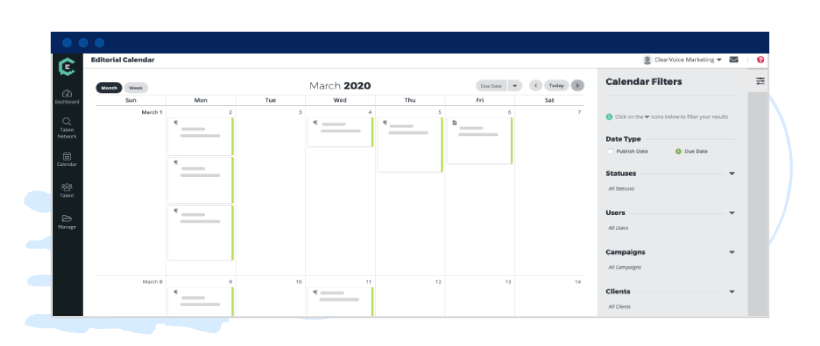Marketers need a carefully crafted content plan to execute content marketing campaigns with clarity and effectiveness.
However, many are still confused about what content plans are, the role they play in content marketing, and how to create one that will yield meaningful results. Fortunately, creating a content plan doesn’t need to be complex.
In this article, we dive into the nitty-gritty of how to create a high-performing content plan so you have a clear framework to follow or build upon.
What is the difference between a content plan and a content strategy?
There are a few key differences between a content plan and a content strategy:
From a 30,000 ft. view, a content strategy articulates your goals for your content marketing campaigns. It is your guiding compass and the foundation of your content plan.
A content strategy doesn’t include your article topics, the dates when your posts ought to be published, etc. Rather, it is a top-level view of what you want your content pieces to accomplish.
Below are three sample content strategy examples.
- Get 200% more leads per month through social media content on Instagram and Facebook.
- Build backlinks through guest posting to increase rankings for the keyword “self-service last-mile deliveries” and boost organic traffic by 90%.
- Create 30-day email campaigns to accelerate lead nurturing for 1,000 existing leads and improve the conversion rate by 100%.
A content plan, on the other hand, focuses on the schematics and outline of individual pieces of content, which will be used to accomplish the content strategy. It includes information like keywords, topics, and related topics to ensure every piece contributes to marketing goals.
Below are some content plan examples.
- 10 pieces of 1,000-word blog posts around the keyword “BMI calculator.”
- 20 video posts for Instagram Stories around the topic “pet grooming.”
- 15 lead nurturing emails for the “Getting to Know You” campaign.
Why you need to create a content plan
To answer this question, you must first understand why content is important.
Content creates a bridge between your business or product and your target audience. It fosters a connection with your potential buyers so you can turn leads into paying customers.
Many companies struggle to create great content because:
- They don’t have the time to research the competitive landscape.
- They don’t have the expertise to develop topics that address the needs of their target customers.
- They don’t understand what their audience is asking or searching for online.
- They don’t have the bandwidth to develop and coach writers.
- They don’t know how to ‘rank’ on search engines or even know what that really means.
- And they don’t know what types or how much content they should create.
A content plan is an organized approach to creating and deploying written, video, audio, multimedia, or interactive content pieces against a defined strategy.
It’s not the strategy itself but rather the plan to publish those pieces themselves across a range of marketing channels — from a company’s owned and operated properties (such as a website) to various social platforms.
What to include in your content plan
Not all content plans are created equal.
Some are ambiguous and lacking, while the high-performing plans have clearly defined steps, are comprehensive, and give your content marketing team clarity.
Consider including these components in your content plan:
- Targets: What marketing goals do you want to accomplish through your content?
- Audience personas: Who is your target audience, and what content do they need?
- Content strategy: What topics and content formats will you use?
- Search Engine Optimization: What are your target keywords, and how will you scale performance against competitors?
- Content team: Who are the people in charge of writing, editing, research, graphic design, and so on?
- Training and onboarding: What are your content guidelines, and are there resources that can help your content team (i.e. templates, proofreading tool, etc.)
- Distribution strategy: How and where will you publish completed content pieces?
- Editorial calendar: When are the deadlines and distribution dates for each piece of content?
- Performance tracking: What are your key content performance metrics, and how will you track them?
What questions should you ask when executing a content plan to fulfill a content strategy?
A content plan can be as complex or simplified as you’d like it to be. What matters is you achieve your content marketing goals. To help you decide how to build your content plan, here are the questions you need to answer:
What are your goals?
Ask yourself why you need to build a content plan.
Are you trying to generate leads, or do you just want improved brand visibility? Or perhaps you’re looking to double your sales?
Understanding your content strategy goals gives you a better picture of how your content plan ought to be developed.
Your goals help you determine which content types you ought to create, your target distribution channels, and the promotion strategies you need to invest in.
How does SEO factor into the greater picture?
You probably have a document that lists the top 10 or so keywords and long-tail keyword phrases you want your website to rank for.
Perfect.
When you create a content plan, however, it’s time to go a level deeper and optimize each piece of content individually for search and intent-based queries.
What types of questions are people asking about and around your product or service? Is your content optimized to address those concerns?
Think about the words your potential customers are using to find your services then optimize your content for those keywords.
Does your content plan fit your current needs?
Conduct a keyword audit of your website every six months to a year to flow with shifts in content marketing trends and audience engagement methods.
Have you considered integrating trending peripheral keywords that offer opportunities to speak to a niche audience?
Have you examined your current competitors and their keywording?
Regular monitoring and updating keep your content plan in alignment with your goals.
How are you approaching on-site and off-site content?
Writing for your company blog isn’t enough.
Create content for partner websites, other branded websites under the umbrella of your parent company, or for industry-leading publications with killer domain authority (DA) and organic search engine traffic.
Stay on top of your off-site SEO by branching out and securing bylines and press mentions beyond your home domain to generate backlinks and referral traffic.
Is the content segmented in a way that aligns with your strategy?
Be mindful of your readers’ customer journey when brainstorming for content topics. Some content topics (or content types) perform better at certain stages.
For example, how-to guides and news-type articles are perfect for the awareness stage. On the other hand, case studies, reviews, and testimonials will do wonders for readers in the decision stage.
Also, remember to share your buyer persona with your writers before or during the content creation phase so everything they produce aligns with your strategy.
We have 25 thought triggers around content strategy and content planning for you to dig into at your next brainstorming session.
3 types of content plans with sample scenarios
Let’s take a look at the three types of content plans and some sample scenarios based on your budget.
1. For brand visibility
Content plans that focus on increasing brand visibility typically use a three-pronged strategy: blogging, social media marketing, and guest blogging.
Blogging is essential for establishing a brand’s credibility as a trusted information source in its industry.
Since most people hang out on social media platforms, it pays for brands to establish their presence on social media sites so their target audience can find them when they conduct their searches.
Guest blogging enables brands to leverage the visibility and authority of other websites. It generates referral traffic to the brand’s official website through backlinks.
2. For keyword rankings
Speaking of backlinks, the guest posts you create can do wonders for your keyword rankings.
Google, together with most search engines, consider the backlink profile of a page to determine if they are rank-worthy.
The more quality backlinks you have, the better your chances of ranking.
Also, a successful SEO content plan is rooted in extensive keyword research, content optimization, link building, and analytics.
This includes researching content themes, topics, titles, and potential link sources. In an SEO-focused content plan, each piece of content is created with a website’s internal structure in mind.
Most agencies do this by creating a topic cluster, which is basically a connection of related posts about subtopics—internally linked together via a pillar post that focuses on the broader parent topic.
3. Conversion-focused
Pay very close attention to your customer journey when creating a conversion-focused content plan.
The customer journey can be broken down into different funnel stages, like awareness, interest, decision, and action.
In this content plan, it’s important for businesses to provide content that matches the intent of leads in each funnel stage:
- Awareness: Curated content, blog posts, social media posts, and website copy.
- Interest: Case studies, product comparisons, tutorials, and reviews.
- Consideration: Landing pages, surveys, downloadables, emails, and webinars.
- Action: Product demo, free trial, and special offers.
Remember that the list above is just an example of how businesses can create a content plan for a basic sales funnel.
In most cases, the sales funnel is a lot more complicated—with a wider variety of lead types, intent, and content channels.
Here’s how to create and budget your content plan (with sample scenarios)
Scenario 1: $5K per month
A great starting point for SMBs is budgeting $5K per month for an outsourced production management service such as ClearVoice.
Although the dynamics of a content marketing campaign vary from business to business, this is a sample of a content plan you could expect to receive over the course of a year with a $5K monthly budget:
- Technical and keyword audit (once annually)
- Ongoing SERP reporting
- 12 pieces of off-site content (one per month)
- 2 white papers (one every 6 months)
- 30 SEO standard blog posts (2-3 per month)
- 2 SEO long-form pillar blog posts or landing pages (one every 6 months)
The types of content produced would shift to meet your needs. Do your consumers thrive on YouTube tutorials rather than white papers? Cool. Funnel those dollars into video production. Every content plan is malleable and ready to pivot based on incoming audience and SERP data.
You’ll need an editorial calendar specific to your content plan to keep everything organized and consistent. This is a day-by-day map of the creative workflow to produce each content asset in the content plan.
We offer an editorial calendar internally to ClearVoice clients who use our platform, but you could also work with a cloud-based system like Google Docs or Google Calendar.
Be sure your editorial calendar offers monthly, quarterly, and annual snapshots to assist with long-range reporting and visual check-ins.
Scenario 2: $10K per month
As you build up your publishing cadence and audience, consider bumping your budget up to $10K.
For the added investment, you gain more content assets, assistance with nurturing direct relationships (think email drip campaigns to stay top-of-mind with prospects in a specific vertical or the opportunity to draw satisfied customers back into the funnel at the repeat stage), and an increase in data gathering to further inform your content strategy.
In addition to the foundation elements listed in the $5K per month content plan above, you might consider increasing your pieces of off-site content to 16 per year, work up to four additional white papers and bump your standard blog post output to 44 and pillar posts to four. Your budget would also have room for four mentions in the press, four infographics, a quarterly newsletter, and four industry-specific drip campaigns.
You could also toss in three months of paid amplification testing to learn even more about how your content performs so you can effectively re-target your warm leads.
This boost in attention to your marketing ultimately helps you stay consistent with your publishing cycle, make a name for your brand and climb to the top of those Google results.
Scenario 3: $15K per month
When you’re ready to scale, this content plan delivers volume, consistency, and ongoing search analytics to even further inform your marketing team and get in front of your customers.
A quick breakdown of what you might enjoy for 15K per month based on the samples we’ve been sharing at the previous two pricing tiers include:
- Everything from the $10K budget
- 6 additional pieces of off-site content
- 2 additional press mentions
- 2 additional white papers
- 28 additional blog posts
- 4 additional pillar posts
- 4 case studies
- Social media posts and distribution
Here you’ll notice the addition of case studies. These evidence-driven narratives are often seen as the holy grail of content assets since they allow the sales team to understand how marketing worked its magic from start to finish while serving as impactful lead nurturing devices that stimulate awareness and trigger conversions.
Case studies can easily become the workhorses of your content plan. As a bonus, they’re easily repurposed into social media snippets, blog posts, and testimonials.
To learn more about how your marketing budget is being spent on content, view this free recorded webinar, “How To Make Content Marketing Magic With $5K, $10K, and $15K Per Month.”
Creating content: In-house vs. working with freelancers, which should you choose?
Initially, it makes sense to see what your team can do.
If you have a well-rounded internal marketing department complete with a director of marketing, a marketing analyst, content strategists, content creators, and a content director, hit the ground running to have a better grasp of your team’s capabilities.
But for most businesses, it’s not uncommon to realize that you simply don’t have the employee bandwidth or expertise to roll out the type of marketing campaigns you dream about executing.
Creating content takes time and talent.
A basic team of content creators would include a managing editor, writers, copy editor, and designer.
As your budget and content plan grow, you need to invest more.
For example, at the $5K budget, you’ll need approximately 4-8 writers available.
At $10K, you should have 6-12 writers working on your projects and for $15K a month, you’ll need 8-16 writers and a dedicated social media manager to get the job done.
If you’re getting very little to no results from your internal content marketing initiatives, it’s time to find a content production partner, like ClearVoice.
How do you assess success and adjust content creation to meet your goals?
The definition of success varies based on your company’s content strategy goals. Is your goal to generate donations for a non-profit? Is it to grow your follower count on Instagram? Or are you looking to bring in leads to your sales team members’ inboxes?
For most of these scenarios, a general metric of success is volume. We all want more of whatever our goal dictates.
When your content plan includes paid amplification, ongoing SERP reporting, and real-time analytics reports based on your KPIs, you can see if your content plan is indeed moving you toward your goals, thus success.
As you move forward in your content marketing initiatives, you’ll see daily, weekly, and monthly trends over time and discover if you’re moving at the pace and scale you initially anticipated.
If you’re not getting the ROI you need, reassess your content creation efforts.
- Which assets are driving the results you need?
- How many leads are you getting? What’s the quality of those leads?
- Can you shift your budget from lower-performing outreach methods to those that are bringing in the numbers?
- How are your leads converting? And, at what rate?
- Are you getting referral traffic from your off-site content and media mentions?
- How much time are readers spending on each page? Are bounce rates decreasing?
- How are your current keywords performing? What’s the traffic like around them?
- Is the content speaking to your buyer personas? Does your customer journey need to be restructured?
- Are you overlooking a content type that your audience wants to be active with?
- Have you created custom metrics that pertain specifically to your brand? (For example, sales numbers per store location, rather than as a company overall.)
- Or maybe everything is working (Hallelujah!) and you need approval for an increase in the marketing budget?
Influence & Co. outlines metrics you should focus on based on goals tied to thought leadership, lead generation, and SEO.
As you dig into the analytics, know that it’s common for businesses to identify times of the year when their numbers dip and spike.
Summer months are often slower for online traffic as summer vacations and outdoor activities draw people away from their devices. Then the holiday season emerges, and everyone takes to their favorite search functions to find the perfect gifts, holiday meal plans, and flight deals.
FAQs for creating a content plan
1. What is the purpose of a content plan?
Content plans ensure your company’s resources are effectively allocated to activities that push toward your content marketing goals. More specifically, it enables teams to stay on the same page and hit objectives within the campaign’s timeline.
2. How do you organize content?
Content can be organized using tags, categories, content maps, and spreadsheets on a platform level. For teams, a content management system or ecosystem, which may include cloud storage services and project management tools, can be used to organize content.
3. What are the different types of content?
There are several types of content that fit specific purposes in a content marketing strategy. Some examples are blog posts, videos, case studies, eBooks, emails, how-to guides, and webinars.
4. What is a content framework?
Content frameworks function as reusable outlines that can help teams create content using consistent styles, guidelines, and formats. Creating content frameworks involves identifying your strategic goals, target personas, related topics, and keywords.
5. What is a content roadmap?
A content roadmap is a visual tool that helps businesses plan, execute, and track the individual content-related steps toward marketing goals.
6. What is a content calendar?
A content calendar is a schedule of when content pieces are published. It can take the form of an actual visual calendar or a spreadsheet with the content titles and scheduled date of publication.
Create a winning content plan now
Content marketing is a long-term effort with lasting results. If you’re ready to take your content marketing campaigns to the next level, ClearVoice can help.
Let’s get your content plan documented and our team of creative freelancers on board to help you achieve your content creation needs.










